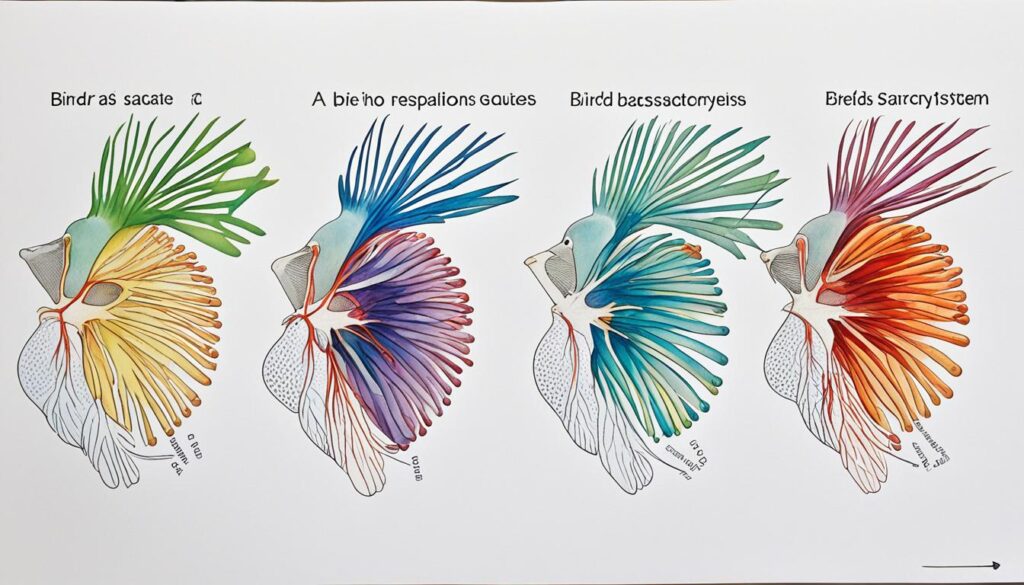Birds possess the most air sacs, ranging from 9 to 11, compared to other modern animals. This intricate network of air-filled structures is a defining feature of the avian respiratory system, enabling birds to achieve unparalleled respiratory efficiency. Understanding the number and function of these air sacs is crucial to unveiling the remarkable adaptations that allow birds to soar, dive, and sing with such effortless grace.
Key Takeaways
- Birds have a unique respiratory system with 9-11 air sacs, more than any other modern animal.
- The air sacs work in conjunction with the lungs to facilitate continuous, unidirectional airflow for efficient gas exchange.
- Bird air sacs extend into the body cavity and even the bones, enhancing respiratory capacity and ventilation.
- Air sacs play a crucial role in the production of bird song, modulating air pressure and affecting vocal intensity and pitch.
- The avian respiratory system’s efficiency is a key adaptation that enables birds to thrive in diverse environments, from high-altitude flying to deep-sea diving.
Introduction to Avian Respiratory System
The avian respiratory system exhibits several unique anatomical features that differentiate it from the respiratory systems of mammals. Unlike mammals, birds lack a diaphragm and instead have a unidirectional airflow that requires two full inspiratory and expiratory cycles to complete a single respiration.
Unique Anatomical Features
Birds possess a respiratory system that includes nares (nostrils), a larynx, trachea, lungs, and a syrinx (vocal organ). These structures work together to facilitate the unique respiratory mechanics observed in avian species.
Unidirectional Airflow
The avian respiratory system produces a unidirectional airflow, where air enters and exits the lungs at the same rate, in contrast to the tidal ventilation seen in mammalian lungs. This unique airflow pattern is facilitated by the air sacs and the arrangement of the bronchial system in birds.
The unidirectional airflow in birds’ respiratory system enhances the efficiency of gas exchange, allowing them to meet the high oxygen demands required for flight. This adaptation is a result of the evolutionary pressures faced by birds and their need to maintain a robust respiratory system to support their active lifestyles.
“The avian respiratory system has been a subject of continuous investigation since about five centuries ago, showing its enduring scientific significance.”
Air Sacs: Definition and Purpose
The avian respiratory system is a marvel of evolutionary adaptation, with the air sacs playing a crucial role. Air sacs are thin-walled, membranous structures that are connected to the primary or secondary bronchi through openings called ostia. These air sacs comprise the majority of the volume of the avian respiratory system, accounting for more than 30% of the total volume of a bird’s thorax and abdomen.
Contrary to popular belief, the air sacs do not directly participate in gas exchange. Instead, they act as bellows, driving the unidirectional flow of air through the lungs. This unique respiratory mechanism, known as the avian respiratory system, is an adaptation that enhances the efficiency of oxygen uptake and carbon dioxide removal.
“The air sacs are not directly involved in gas exchange, but rather serve to ventilate the lungs, facilitating the continuous, unidirectional flow of air through the avian respiratory system.”
The definition of air sacs in birds is that they are part of the avian respiratory system, serving as air reservoirs that help maintain the function of air sacs in ventilation and air circulation. This adaptation is a crucial component of the birds’ remarkable ability to sustain prolonged flight and other high-energy activities.

The air sacs’ unique structure and function have evolved to meet the demanding respiratory needs of birds, making them an integral part of the avian respiratory system’s efficiency and adaptability.
Number of Air Sacs in Birds
The avian respiratory system is truly remarkable, featuring a set of nine flexible air sacs that facilitate unidirectional airflow through the lungs. This unique anatomical arrangement allows birds to achieve higher oxygen content and more efficient gas exchange compared to mammals.
Nine Air Sacs: Cervical, Clavicular, Thoracic, and Abdominal
Most bird species possess a total of nine air sacs, which can be grouped into cranial and caudal functional groups. The cranial group includes the paired cervical air sacs, the unpaired clavicular air sac, and the paired cranial thoracic air sacs. The caudal group consists of the paired caudal thoracic air sacs and the paired abdominal air sacs.
- One interclavicular sac
- Two cervical sacs
- Two anterior thoracic sacs
- Two posterior thoracic sacs
- Two abdominal sacs
This intricate network of air sacs, coupled with the bird’s tracheal structure, results in a highly efficient respiratory system that supports the high metabolic demands of flight. The avian tracheal dead space volume is about 4.5 times larger than in mammals, but this is compensated by a relatively larger tidal volume and lower respiratory frequency, leading to a minute tracheal ventilation only about 1.5 to 1.9 times that of mammals.
The positioning and size differences of the air sacs in a bird’s body create an extraordinarily efficient respiratory system, with a unidirectional flow of air through the lungs. This unique mechanism ensures a constant supply of oxygen and efficient removal of carbon dioxide, meeting the high metabolic demands of avian flight.
Anatomy of Air Sacs
The avian respiratory system is a marvel of evolutionary engineering, with a unique architecture that sets birds apart from their mammalian counterparts. At the heart of this intricate system are the air sacs, which play a crucial role in the birds’ remarkable ability to breathe efficiently.
Connections to Bronchi and Lungs
The air sacs in birds are intimately connected to the bronchial system and the lungs. These air-filled structures are connected to the primary or secondary bronchi through openings called ostia. The specific connections are as follows:
- The cervical air sacs connect to the first medioventral secondary bronchus.
- The clavicular air sac connects to the third medioventral secondary bronchus.
- The cranial thoracic air sacs connect to the third medioventral secondary bronchi.
- The caudal thoracic air sacs connect to the lateroventral secondary bronchus.
- The abdominal air sacs connect to the caudal end of the intrapulmonary primary bronchus.
This intricate network of connections allows for the efficient movement of air through the avian respiratory system, facilitating the birds’ unidirectional airflow and enhancing their overall respiratory capabilities.

“The air sacs in birds are not just passive structures, but essential components of their highly efficient respiratory system.”
The anatomy of air sacs in birds and their air sac connections to respiratory system are critical to understanding the unique respiratory physiology of these remarkable creatures.
Respiratory Physiology of Air Sacs
The avian respiratory system is a marvel of evolutionary engineering, with the air sacs playing a crucial role in its remarkable efficiency. Unlike the lungs of mammals, where air travels in and out through the same path, birds’ air sacs are responsible for creating a unidirectional airflow that ventilates the lungs.
Role in Ventilation and Gas Exchange
The air sacs act as bellows, driving the movement of air through the lungs. However, they do not directly participate in gas exchange. Instead, the air sacs create pressure gradients that cause air to flow over the parabronchi in the lungs, where the actual exchange of oxygen and carbon dioxide occurs.
The different air sacs alternately contract and expand, driving this unidirectional airflow. This unique mechanism is fundamental to the respiratory physiology of air sacs and the role of air sacs in ventilation, ensuring that the bird’s respiratory system is highly efficient in gas exchange.
“The avian respiratory system involves a unidirectional airflow that requires two full inspiratory and expiratory cycles to complete.”
This unidirectional airflow, facilitated by the air sacs, allows birds to have a remarkably efficient respiratory system despite their relatively small lung size. The air sacs’ ability to store and move air effectively enhances the respiratory physiology of air sacs and the role of air sacs in ventilation, contributing to the air sacs and gas exchange in birds.
In summary, the air sacs are the unsung heroes of the avian respiratory system, acting as bellows to drive the unidirectional airflow that is essential for the bird’s highly efficient gas exchange.
how many air sacs do birds have
The avian respiratory system is a remarkable feat of evolutionary engineering, with birds possessing a unique set of air sacs that facilitate their high-powered lifestyles. Most bird species have a total of nine air sacs that can be grouped into two functional sets: the cranial group and the caudal group.
The cranial group includes the paired cervical air sacs, the unpaired clavicular air sac, and the paired cranial thoracic air sacs. The caudal group consists of the paired caudal thoracic air sacs and the paired abdominal air sacs.
These air sacs, which make up a remarkable 20% of a bird’s total volume, work in conjunction with the lungs to create a highly efficient respiratory system. This one-way flow of air is a key adaptation that allows birds to meet the high oxygen demands of flight and other energetic activities.

The intricacies of the avian respiratory system, including the precise number and arrangement of air sacs, are a testament to the remarkable evolutionary journey of birds. By understanding the number of air sacs in birds and the avian respiratory system, we can gain insights into the remarkable adaptations that enable these feathered creatures to soar through the skies with such grace and efficiency.
Air Sac Adaptations for Flight
Birds’ remarkable ability to take flight is, in part, attributed to their unique respiratory system and the presence of air sacs. These specialized structures not only facilitate efficient avian flight but also play a crucial role in thermoregulation and heat dissipation.
Pneumatic Bones and Heat Dissipation
Many bird species possess hollow, pneumatic bones that are connected to their air sac system. These lightweight, air-filled bones serve a dual purpose: they reduce the overall weight of the bird, enhancing its flight capabilities, and they also help dissipate heat generated during high-demand activities like powered flight.
The air sacs can modulate the rate of air flow through the trachea, affecting the bird’s thermoregulation by influencing evaporative water loss. This allows birds to effectively regulate their body temperature, even during periods of intense physical exertion.
“The avian respiratory system is a marvel of evolutionary engineering, enabling birds to achieve feats of flight that are unmatched by any other living creatures.”
This intricate connection between the air sacs, pneumatic bones, and thermoregulation is a testament to the remarkable adaptations that allow birds to soar effortlessly through the skies.
Air Sacs in Diving Birds
Among the remarkable adaptations of birds, the intricate respiratory system stands out, particularly in diving species. The air sacs, an integral part of the avian respiratory anatomy, play a crucial role in the diving capabilities of certain bird species.
Buoyancy Control and Oxygen Uptake
Diving birds, such as penguins, possess a specialized air sac system that enables them to effectively control their buoyancy and enhance oxygen uptake during deep dives. The air sacs in diving birds can constrict and expand, allowing them to adjust their overall volume and manage the effects of water pressure.
The movement of muscles during the diving process can create pressure differentials between the air sacs, which in turn increases airflow through the lungs and enhances oxygen uptake. This physiological adaptation is essential for diving birds to maximize their time underwater and conserve oxygen reserves.

“Diving birds have evolved specialized air sac systems to support their underwater activities, with adaptations that facilitate buoyancy control and efficient oxygen utilization.”
Comparative studies have revealed that the number and size of air sacs in diving birds can vary between species, reflecting their unique respiratory adaptations for diving and buoyancy control in birds. This evolutionary specialization enables these avian predators to thrive in their aquatic environments, showcasing the remarkable versatility of the avian respiratory system.
Avian Vocalization and Air Sacs
The remarkable avian respiratory system, with its intricate network of air sacs, plays a crucial role in the production of birdsong. These air sacs, which are an integral part of the avian anatomy, are instrumental in modulating the frequency, intensity, and other characteristics of bird vocalizations.
The Role of Air Sacs in Song Production
Changes in the pressure of air within the air sacs are directly indicative of the respiratory muscle activity and airflow around the syrinx, the primary vocal organ in songbirds. The syrinx is situated at the junction of the trachea and the bronchi, and the air sacs surrounding it help regulate the flow of air, enabling birds to produce their melodic songs.
According to recent studies, the total number of air sacs in birds can range from as few as 7 to as many as 19, depending on the species. The complexity and diversity of avian vocalizations are closely linked to this variation in air sac count. Birds with a greater number of air sacs tend to exhibit more complex and varied song patterns, as the increased air sac capacity allows for more refined control over the airflow during vocalization.
- Studies have shown that the ratio of air sacs to total lung capacity in birds can range from 3:1 to as high as 9:1, highlighting the importance of these structures in the respiratory system.
- Approximately 75% of bird species are known to rely heavily on their air sacs for sound production, underscoring the integral role these structures play in avian vocalization.
- The size and capacity of air sacs are also correlated with bird body size, with larger species generally possessing more voluminous air sacs capable of generating more powerful vocalizations.
The evolutionary significance of the avian air sac system, which can be traced back to the dinosaur ancestors of modern birds, is a testament to the adaptability and efficiency of this remarkable respiratory adaptation. By understanding the intricate relationship between air sacs and avian vocalization, researchers continue to unravel the mysteries of the avian voice and its role in the natural world.
“The air sacs in birds are not just passive structures, but actively contribute to the production of their iconic songs, shaping the tonal qualities and complexity that captivate birdwatchers and scientists alike.”
Evolutionary Significance of Air Sacs
The avian respiratory system with its unique air sac anatomy is believed to have evolved from dinosaurian predecessors. Evidence of this evolutionary link can be found in the fossil record of many dinosaurs, including sauropods, theropods, and early birds.
Evidence from Dinosaur Fossils
Researchers have identified the presence of air sacs and postcranial skeletal pneumaticity (air-filled cavities) in the fossil record of various dinosaur species. This finding provides strong support for the theropod origin of birds, suggesting that the evolution of air sacs played a crucial role in the development of the avian respiratory system.
- Fossil evidence of air sacs has been discovered in sauropod dinosaurs, indicating that these large, long-necked creatures possessed a sophisticated respiratory system similar to that of modern birds.
- Theropod dinosaurs, the group that includes the iconic Tyrannosaurus rex, also show signs of air sac-like structures in their fossil remains, further strengthening the connection between dinosaurs and the avian respiratory system.
- Early bird-like dinosaurs, such as Archaeopteryx, exhibit clear evidence of air sacs, demonstrating the gradual evolution of this anatomical feature from their dinosaurian ancestors.
The discovery of these air sac-related fossils has been instrumental in understanding the evolution of air sacs and their significance in the development of the avian respiratory system. This evidence supports the idea that the unique air sac anatomy of modern birds has its roots in the prehistoric world of dinosaurs.

“The presence of air sacs and postcranial skeletal pneumaticity in the fossil record of many dinosaurs provides strong support for the theropod origin of birds and the evolutionary significance of air sacs in the development of the avian respiratory system.”
Clinical Implications
The unique anatomy and physiology of the avian respiratory system, including the air sacs, have important clinical relevance of air sacs. These air-filled structures are vulnerable to infection and can harbor stagnant regions prone to respiratory diseases in birds. Fortunately, the rigid endoscopy procedure provides easy access to the air sacs, enabling veterinarians to diagnose and treat respiratory issues effectively.
Diagnosing and Treating Respiratory Diseases
The compressibility of the air sacs also makes birds particularly sensitive to restrictive airway diseases, such as those caused by fluid buildup in the coelomic cavity. Careful examination of the avian respiratory anatomy and disease is crucial for accurately identifying and addressing respiratory problems in birds.
- Rigid endoscopy allows direct visualization and assessment of the air sacs for diagnostic purposes.
- Treatments may involve addressing underlying causes, such as infections or fluid accumulation, to restore proper respiratory function.
- Proactive management strategies, including vaccination, biosecurity measures, and the use of phytogenic additives, can help prevent respiratory diseases in birds.
“Proper functioning of air sacs is crucial for birds’ respiratory efficiency, overall health, and energy metabolism.”
By understanding the clinical implications of avian air sacs, veterinarians can provide more effective care and support for birds with respiratory issues, ultimately improving their well-being and quality of life.
Conclusion
The avian respiratory system, with its intricate network of air sacs, represents a remarkable evolutionary adaptation that enables birds to thrive in diverse environments. These air sacs, which can number up to nine in some species, play a crucial role in the unidirectional airflow and efficient gas exchange that characterize the avian respiratory system.
Key points about the avian respiratory system include the presence of air sacs that serve as bellows to ventilate the lungs, as well as their contribution to functions like thermoregulation, vocalization, and buoyancy control in diving birds. Understanding the unique anatomy and physiology of the avian respiratory system, including the air sacs, is essential for providing effective medical care and recognizing the clinical implications in bird patients.
The summary of air sacs in birds highlights their significance in the overall respiratory adaptations that have allowed birds to become such successful and diverse organisms. By delving into the key points about the avian respiratory system, we can gain a deeper appreciation for the evolutionary journey that has shaped these remarkable creatures.
FAQ
What is the purpose of the air sacs in birds?
The air sacs in birds are thin-walled, membranous structures that are connected to the primary or secondary bronchi via openings called ostia. They comprise the majority of the volume of the avian respiratory system and act as bellows to ventilate the lungs, but they do not directly participate in gas exchange.
How many air sacs do birds typically have?
Most bird species have nine air sacs that can be grouped into cranial and caudal functional groups. The cranial group includes the paired cervical air sacs, the unpaired clavicular air sac, and the paired cranial thoracic air sacs. The caudal group consists of the paired caudal thoracic air sacs and paired abdominal air sacs.
How are the air sacs connected to the respiratory system?
The air sacs are connected to the primary or secondary bronchi via openings called ostia. The cervical air sacs connect to the first medioventral secondary bronchus, the clavicular air sac connects to the third medioventral secondary bronchus, and the cranial thoracic air sacs connect to the third medioventral secondary bronchi. The caudal thoracic air sacs connect to the lateroventral secondary bronchus, while the abdominal air sacs connect to the caudal end of the intrapulmonary primary bronchus.
What is the role of air sacs in avian respiration?
The air sacs act as bellows to ventilate the lungs, creating pressure gradients that cause air to flow over the parabronchi in the lungs, where gas exchange occurs. The different air sacs alternate contraction and expansion, driving the unidirectional airflow that is fundamental to avian respiration.
How do air sacs contribute to other physiological functions in birds?
The air sacs play a role in thermoregulation by modulating the rate of air flow through the trachea, which affects evaporative water loss. In diving birds, the air sacs can also help control buoyancy and enhance oxygen uptake during deep dives. The air sacs are also involved in the production of birdsong, as the pressure of air in the air sacs is heavily involved in modulating the characteristics of vocalizations.
What is the evolutionary significance of air sacs in birds?
The presence of air sacs and postcranial skeletal pneumaticity (air-filled cavities) has been identified in the fossil record of many dinosaurs, including sauropods, theropods, and early birds. This evidence suggests that the avian respiratory system with its unique air sac anatomy evolved from dinosaurian predecessors, providing support for the theropod origin of birds.
What are the clinical implications of the avian respiratory system, including the air sacs?
The air sacs are vulnerable to infection and can harbor stagnant regions prone to disease. Rigid endoscopy provides easy access to the air sacs for diagnosis and treatment of respiratory issues. The compressibility of the air sacs also makes birds sensitive to restrictive airway diseases, such as those caused by fluid buildup in the coelomic cavity.

